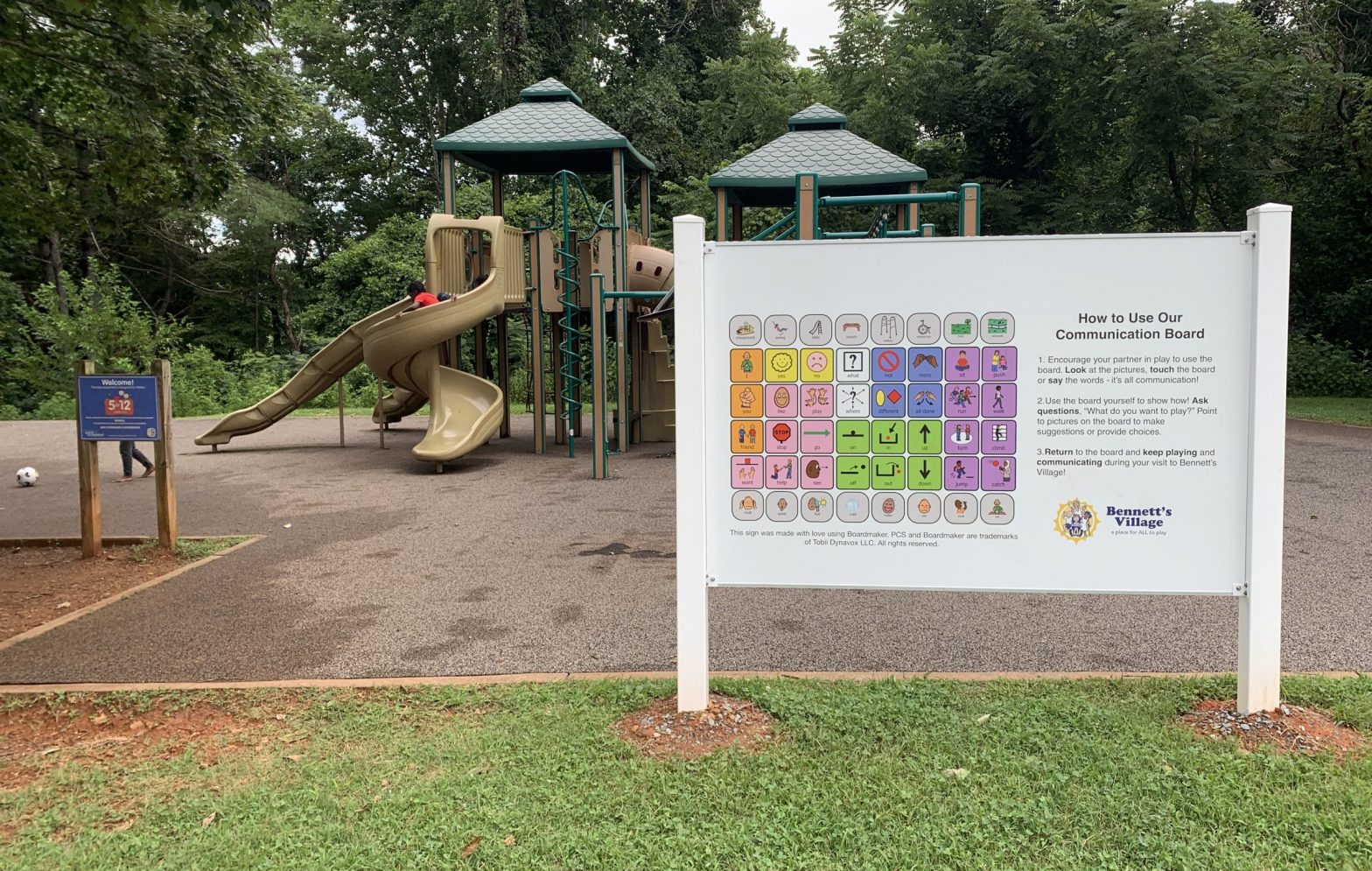When I got to Pen Park, the sky was threatening to open up and pour, as it had just hours before. Kara McClurken was keeping a close eye on the rain clouds as she zipped from person to person gathered at the playground. She was eager to get things started before the weather decided otherwise. This was a monumental occasion.
Here, planted in front of the slides and monkey bars, was McClurken’s latest project waiting to be unveiled: a grid of symbols printed on a large white sign. This new interactive element wasn’t there to be spun or climbed on, but to be used as a tool and reference for all children and caregivers to point at and better communicate with each other—a communication board. All the expected symbols are there: “Yes,” “No,” “Friend,” “Play,” “Swing,” “Slide.” But the board also includes more abstract terms, with prepositions (“In,” “Out,” “On,” “Off”), questions (“What?” “Where?”), and verbs (“Sit,” “Run,” “Catch”).
When the time came to present the installation to the public, McClurken stood proudly beside the board. “Communication boards not only provide tools for our nonverbal neighbors to communicate their desires,” she said to the crowd, “but just as important, they send a message to the rest of us that this space is an inclusive and welcoming place for everyone.”
There’s a lot of weight in McClurken’s words about “this space.” The 3.2 acres surrounding the existing play area are reserved by Charlottesville Parks & Recreation for the eventual development of a yearslong, more than $5 million accessible and inclusive playground. In a way, the communication board is a statement of intent for the park—the first completed project by local nonprofit Bennett’s Village, of which McClurken is co-founder and president. The organization is named for McClurken’s son, who lived with spinal muscular atrophy and used a powered wheelchair to get around. Her experience searching for an accessible park for him inspired her to found the nonprofit the day after Bennett died in 2018. The board signals to parkgoers that Bennett’s Village isn’t just an elaborate concept: It’s coming to fruition right here in Pen Park. And that, hopefully, will encourage contributions to their effort.
“As a nonprofit, you need to raise money,” says Riaan Anthony, deputy director of Parks & Recreation. “And in order to raise money, you have to put something in the ground.”
The genesis of the Pen Park communication board was in a Google search. Emily Hillaker, a chief resident physician in physical medicine and rehabilitation at UVA, wanted to secure grant funding for accessible playground equipment in Charlottesville. When looking for someone to partner with, Bennett’s Village popped up.
“Their idea was a thousand times bigger than mine,” says Hillaker. “So I reached out to Kara, and they said, ‘Sure, go for it,’ to apply on their behalf.” When Hillaker became the first ever to win the $1,500 Rob Gotlin Community Leadership grant, they both agreed to put the money toward something that could be completed and installed in just a few months.
The design of the board itself was led by Margaret Hess and Susan Reed, who are assistive technology facilitators at the Piedmont Regional Education Program, which offers a variety of services for students with disabilities.
“A lot of people hear the word ‘technology’ and they think very hi-tech, and that is a lot of what we do,” says Reed. “But the definition of assistive technology is any item, whether it’s specialized or just off the shelf—could be from Walmart—that helps a person with a disability achieve a goal.”
Reed says that she and Hess have had to become “really good detectives” in problem-solving for student needs. And for the communication board, which they’ve previously developed for local schools, they worked with McClurken to determine exactly what symbols (drawn from an elaborate program called Boardmaker) would be best suited to kids of all abilities and backgrounds. That meant being considerate of pronouns, the depiction of people in the images, and sign language gestures for certain terms.
“Accessibility … requires a team,” says Hess. “It cannot be done just by one person alone. You have to be in it with people who really want to make the environment around us—whether it be digital or a playspace—accessible to all people.”
